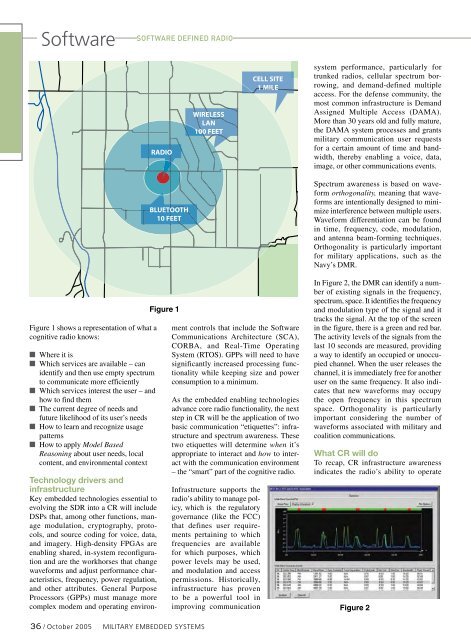Military Embedded Systems - Fall 2005 - Volume 1 Number 2
Military Embedded Systems - Fall 2005 - Volume 1 Number 2
Military Embedded Systems - Fall 2005 - Volume 1 Number 2
Create successful ePaper yourself
Turn your PDF publications into a flip-book with our unique Google optimized e-Paper software.
Software<br />
Software Defined Radio<br />
RADIO<br />
WIRELESS<br />
LAN<br />
100 FEET<br />
CELL SITE<br />
1 MILE<br />
system performance, particularly for<br />
trunked radios, cellular spectrum borrowing,<br />
and demand-defined multiple<br />
access. For the defense community, the<br />
most common infrastructure is Demand<br />
Assigned Multiple Access (DAMA).<br />
More than 30 years old and fully mature,<br />
the DAMA system processes and grants<br />
military communication user requests<br />
for a certain amount of time and bandwidth,<br />
thereby enabling a voice, data,<br />
image, or other communications events.<br />
BLUETOOTH<br />
10 FEET<br />
Spectrum awareness is based on waveform<br />
orthogonality, meaning that waveforms<br />
are intentionally designed to minimize<br />
interference between multiple users.<br />
Waveform differentiation can be found<br />
in time, frequency, code, modulation,<br />
and antenna beam-forming techniques.<br />
Orthogonality is particularly important<br />
for military applications, such as the<br />
Navy’s DMR.<br />
Figure 1 shows a representation of what a<br />
cognitive radio knows:<br />
Technology drivers and<br />
infrastructure<br />
Key embedded technologies essential to<br />
evolving the SDR into a CR will include<br />
DSPs that, among other functions, manage<br />
modulation, cryptography, protocols,<br />
and source coding for voice, data,<br />
and imagery. High-density FPGAs are<br />
enabling shared, in-system reconfiguration<br />
and are the workhorses that change<br />
waveforms and adjust performance characteristics,<br />
frequency, power regulation,<br />
and other attributes. General Purpose<br />
Processors (GPPs) must manage more<br />
complex modem and operating environn<br />
n<br />
n<br />
n<br />
n<br />
n<br />
Where it is<br />
Which services are available – can<br />
identify and then use empty spectrum<br />
to communicate more efficiently<br />
Which services interest the user – and<br />
how to find them<br />
The current degree of needs and<br />
future likelihood of its user’s needs<br />
How to learn and recognize usage<br />
patterns<br />
How to apply Model Based<br />
Reasoning about user needs, local<br />
content, and environmental context<br />
Figure 1<br />
ment controls that include the Software<br />
Communications Architecture (SCA),<br />
CORBA, and Real-Time Operating<br />
System (RTOS). GPPs will need to have<br />
significantly increased processing functionality<br />
while keeping size and power<br />
consumption to a minimum.<br />
As the embedded enabling technologies<br />
advance core radio functionality, the next<br />
step in CR will be the application of two<br />
basic communication “etiquettes”: infrastructure<br />
and spectrum awareness. These<br />
two etiquettes will determine when it’s<br />
appropriate to interact and how to interact<br />
with the communication environment<br />
– the “smart” part of the cognitive radio.<br />
Infrastructure supports the<br />
radio’s ability to manage policy,<br />
which is the regulatory<br />
governance (like the FCC)<br />
that defines user requirements<br />
pertaining to which<br />
frequencies are available<br />
for which purposes, which<br />
power levels may be used,<br />
and modulation and access<br />
permissions. Historically,<br />
infrastructure has proven<br />
to be a powerful tool in<br />
improving communication<br />
In Figure 2, the DMR can identify a number<br />
of existing signals in the frequency,<br />
spectrum, space. It identifies the frequency<br />
and modulation type of the signal and it<br />
tracks the signal. At the top of the screen<br />
in the figure, there is a green and red bar.<br />
The activity levels of the signals from the<br />
last 10 seconds are measured, providing<br />
a way to identify an occupied or unoccupied<br />
channel. When the user releases the<br />
channel, it is immediately free for another<br />
user on the same frequency. It also indicates<br />
that new waveforms may occupy<br />
the open frequency in this spectrum<br />
space. Orthogonality is particularly<br />
important considering the number of<br />
waveforms associated with military and<br />
coalition communications.<br />
What CR will do<br />
To recap, CR infrastructure awareness<br />
indicates the radio’s ability to operate<br />
Figure 2<br />
36 / October <strong>2005</strong> <strong>Military</strong> EMBEDDED SYSTEMS
















